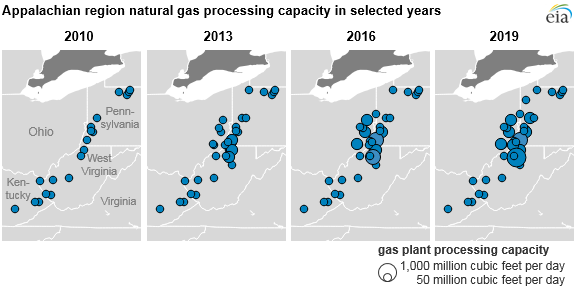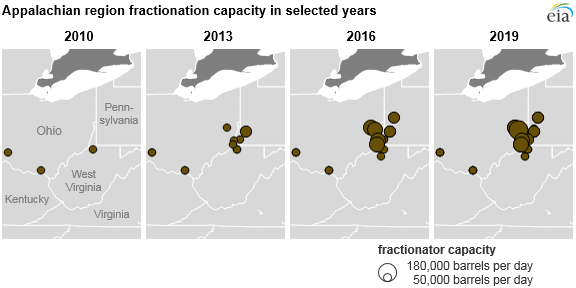Ethane processing has grown from zero to 200,000 b/d
The massive growth in natural gas production in the Marcellus has spurred corresponding growth in gas processing capacity, according to a note from the EIA. Natural gas processing separates dry gas from the valuable natural gas liquids, and typically removes contaminants like water, carbon dioxide and sulfur.
The EIA reports that natural gas production from the Appalachia region has grown from less than 2 Bcf/d in January 2010 to over 24 Bcf/d today, a twelvefold increase. Like pipeline capacity, processing capacity is only now catching up with this tremendous growth. Gas processing in Kentucky, Ohio, Pennsylvania and West Virginia has grown from 1.1 Bcf/d in 2010 to 10 Bcf/d today. Further growth is planned, with an additional 2.5 Bcf/d expected in the next two years.
The most modern processing facilities use advanced compressors and chillers to cool natural gas, allowing easier separation of dry natural gas from liquids. These plants can recover more propane than older units, and can more easily adjust to extract more or less ethane.
This is an important capability, as ethane prices are currently favorable to natural gas, meaning it is profitable to sell ethane separately rather than leave it in the gas stream. Economics and requirements set by pipeline operators mean the ideal amount of extracted ethane varies, giving modern plants with the ability to vary this amount an advantage. The EIA reports that there were no facilities to extract ethane in 2010, but development has led to current levels of 200,000 barrels per day.
NGL fractionation 20 times higher than in 2010
Natural gas liquids require fractionation to become separate, marketable products. The EIA reports that in the Appalachian region all liquids extracted are fractionated locally, unlike in other regions. This means fractionation capacity has increased significantly in this decade, growing twentyfold from 41,000 barrels per day in 2010 to 850,000 barrels per day today. Further development could push this to 1.1 million barrels per day in 2019.




